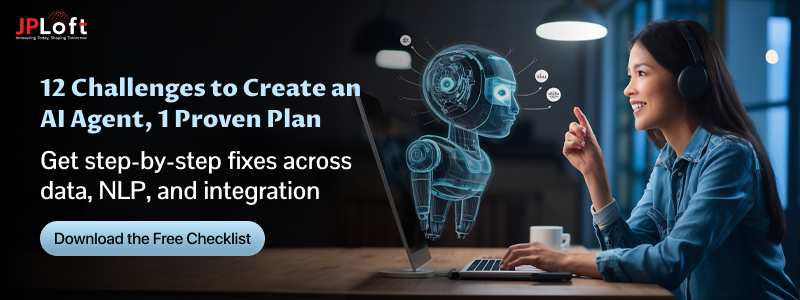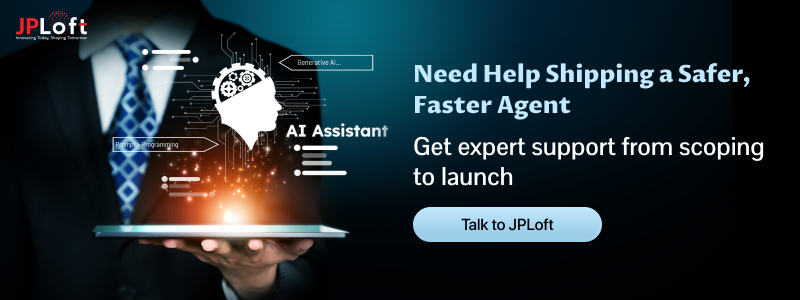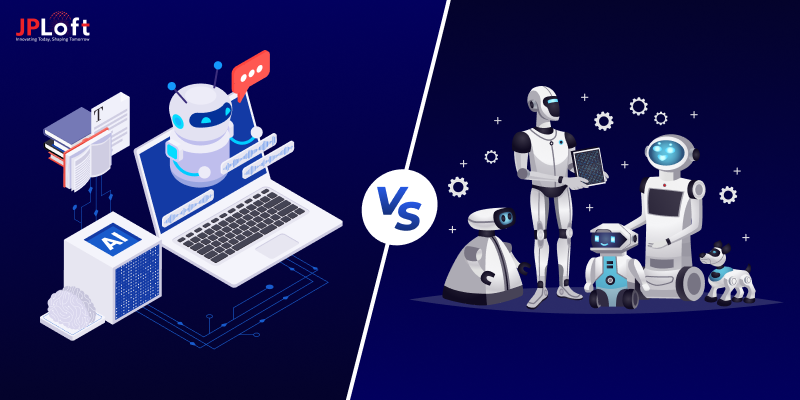“Simplicity is a prerequisite for reliability.: Edsger W. Dijkstra”
This is exactly why AI agents are so compelling. AI agents promise something bigger than chat: software that understands goals, takes action across tools, and learns from each outcome.
Think scheduling a complex trip, reconciling invoices, triaging support, that too without hand-holding. When they work, they save time, cut costs, and make products feel smarter.
Here’s the thing: building that kind of autonomy is as much engineering and design as it is model choice. You need the right data foundations, clear user intent, guardrails, and an experience people trust.
We’ll start by unpacking the core challenges to create an AI agent, from handling messy data and scaling models to securing integrations and meeting compliance needs.
By the end, you’ll have a sharper view of the hurdles ahead and why addressing them early is key to building agents that are dependable, explainable, and fit for real-world use.
Let’s get started.
Key Takeaways
Building AI agents comes with key challenges like messy data, complex NLP, fragile integrations, scaling issues, and strict compliance needs.
Clean and unbiased data ensures accurate results, reduces bias, and prevents costly errors.
Advanced NLP design helps agents capture intent, context, and multi-language communication effectively.
Strong security and compliance safeguards protect sensitive data and maintain long-term user trust.
Scalable architecture keeps AI agents efficient, fast, and affordable even under heavy demand.
Continuous monitoring and transparency drive reliability, accountability, and better decision-making over time.
Emerging AI agent trends such as edge inference and model tiering improve speed, performance, and cost-efficiency.
Understanding AI Agents
AI agents are the software systems that use artificial intelligence to perform tasks and achieve goals autonomously without constant human supervision.
These agents are different from traditional AI or chatbots in exhibiting more independent decision-making, along with the capacity for handling complicated workflows.
It does refer to a program and system that is capable of autonomously performing the task on behalf of a user or another system.
The AI agents are like the layers on top of the language models that help to observe and collect the information, by providing the input to the model, and then together generate the personalized solutions that cater to the demands and queries of the users.
The key features of the AI agents comprise autonomy, interaction with the environment, learning and adoption, multi-modal capabilities, along with reasoning and planning.
An agent is designed to tackle specific tasks, from acting as a virtual project manager to handling more complex assignments, such as reconciling financial statements and closing the books.
Now, as you have understood the concept of an AI agent, let’s have a close look at the challenges in the section below.
Challenges & Solutions to Create an AI Agent
Do you want to convert the AI agent idea to success, but are worried about any errors and issues?
Well, then, learning about the challenges can be helpful.
Let’s evaluate the key challenges that might occur while building an AI agent in this section.
1. Data Quality and Availability
Challenge: Inappropriate data quality
Without any kind of high-quality data, your AI models can produce biased results, might waste valuable resources, which can end up in missing key opportunities. You should note here that the data quality crisis can impact your competitive market position.
Additionally, the poor data quality can hinder the successful deployment of AI and ML projects. Even the most advanced AI algorithms can yield flawed results.
Here, it's important to consider that an AI agent completely relies on the data; hence, if your agent collects outdated or insecure data, then it won’t be able to provide accurate results to the users.
Solution: Robust Data Governance
The appropriate solution is to establish clear data quality standards by implementing automated validation checks and addressing any biases proactively.
Hence, here, you need to establish the standardized guidelines with clear protocols for data entry, validation, and data classifications.
Additionally, you should opt for regular audits and compliance assessments helpful in detecting and addressing violations, security gaps, and mismanagement issues early.
2. Complicated Natural Language Processing (NLP)
Challenge: Complex NLP
One of the issues that you might go through is a complicated NLP structure. Unlike structured data, natural language is full of ambiguity. When it comes to the human language, it is messy; here, the same word might contain different meanings.
Hence, when it comes to analyzing the human language, the context and intent of humans are hard to capture. For instance, here, “yeah, right” could be an agreement or sarcasm.
Along with this, the continuously evolving slang and language. Global apps do expect the agents to work in multiple languages, dialects, or even combine the text, voice, and image inputs. Therefore, identifying the human perspective and intention in this respect can be a significant challenge in building an AI agent.
Solution: Use of LLMs and Contextual Memory
Here, instead of building NLP from scratch, you should leverage models such as GPT, BERT, or LLaMA. This will end up in helping you understand a broad range of contexts, idioms, and linguistic structures, which will lead to cutting down complexity and training costs.
You should add the short-term or session-based memory to help them track the conversations, intent, and context. Along with this, to replace the general model, you can add fine-tuning with the domain-specific datasets that will make the agent more accurate in that area.
Along with this, you should combine AI NLP with the rule-based systems for safety nets. For handling banking-related queries, the domain-specific AI agent can answer conversational issues, and can switch to fixed rules for compliance-critical interactions.
3. Security and Privacy Concerns
Challenge: Security and Privacy Related Concerns
You should note that the AI agents often handle sensitive data that might be financial, health-related, and even personal. The AI agents often process the personal, financial, and even the medical information. Hence, if the data pipelines are not secure, then there can be a larger risk of data leaks.
Whether it's about building an AI app or an agent, there are strict regulations and rules to be followed as per GDPA, HIPAA, and CCPA; avoiding them can result in high fines or bans from operating in certain regions.
Here, another critical AI agent development challenge is that it can be attacked through data poisoning or prompt injection. Such attacks do compromise both the accuracy and security of the AI agent. This might lead to the trust gap among the users.
Solution: Robust Security Measures
You should implement the robust security measures here. It is important to use end-to-end encryption for data at rest and in transit. Here, it's important to integrate secure protocols (HTTPS, TLS, AES-256) for preventing unauthorized access.
Along with this, you should build systems that are aligned with the GDPR, HIPAA, and CCPA regulations from day one. Here, you should maintain clear data retention and deletion policies. This will further help you to maintain data transparency.
It's important to implement secure model training, and using federated learning is further helpful to avoid data poisoning. You should secure the third-party integrations by using token-based authentication and by restricting data sharing to only what’s significant.
4. Lack of Scalability and Performance
Challenge: Scalability and Performance Limitations
The AI agents that run smoothly with a few users might slow down when thousands of users interact simultaneously. Here, the cost increases rapidly, especially for continuous interface and training.
Along with this, the costs increase rapidly, especially for continuous interference or training. When you scale up the AI agent, you might struggle to balance performance with the budget.
Apart from this, storing, managing, and processing large data might be a bottleneck here that can impact your AI agent and its ability to serve the users.
Solution: Optimize the AI Agent and Scale-up
You should optimize the AI agent and scale it up. It's important to have microservices with clear boundaries for retrieval, orchestration, and analytics. Here, it's essential to use event-driven queries for backpressure, spikes, and retries.
It’s important to keep a tiered model strategy and implement a small model for routine queries and a larger model for escalations. In line with emerging AI agent trends, you should also make the retrieval process cheap and fast by running lightweight inference at the edge.
Another significant strategy to note here is streamlining the responses to cut perceived latency. You can put a global API gateway in front with the rate limiting and circuit breakers. Along with this, you should use the provisioned capacity for the predictable peaks. This will help you scale up the AI agents catering to the diverse demands of the users.
5. Integration Obstacles
Challenge: Integration Bottlenecks
An integration with third-party vendors can be a challenge to overcome while building an AI agent. This can further create hurdles in accessing the data, system compatibility, and evaluating the performance of these agents.
You might note that integrating AI agents with the existing systems can face compatibility issues due to the challenges in architecture, APIs, and within the data formats.
The challenge is related to connecting the AI agent to the legacy systems and messy APIs. Along with this, the inconsistent schemas slow everything down.
Solution: Develop Resilience and Improve Security
To address the challenge related to the integration, it is important to build resilience and make your app exposed to versioned REST/GraphQL endpoints, along with adding quirks inside the adapter layer. This will help normalize the pagination, errors, and auth in one place.
Along with this, to address this AI agent development challenge, you should add a thin layer of plugins with the standard interfaces for the LLMs, vector DBs, search, and payments. This will help you to make the third-party vendors swappable in case of any fraud or uncertainty.
Here, you should integrate the databases safely by adopting OAuth2/OIDC, mTLS for service-to-service, scoped tokens, and automatic secret rotation. Additionally, you should create per-provider normalizers that map fields to your canonical model and standardize error codes. This will help you solve the inconsistent schemas at the source.
6. Cost and Resource Constraints
Challenge: Limited Resources
Developing an AI agent can be resource-constrained, particularly for startups and small businesses. Here, the development process requires skilled talent, high-quality data, powerful computing resources, and time.
Here, the cost to develop an AI agent can be overwhelming for small businesses. For analysing the cost, they need to look for multiple factors, including features, complexity, skills of developers, etc.
Thus, optimizing this cost can be a tough AI agent app development challenge for small businesses. This can impact their decision to add AI in mobile apps, and even to create an agent.
Solution: Optimization of resources
You can start with the smallest model, before you even try a giant one. Additionally, you should trim the system prompt, remove fluff, and repeat rules. This will help to wrap vendors behind adaptors so that you can switch to the cheaper options faster.
Emit the cost, tokens in/out, model used, and cache hit status for every call. Along with this, you should set budgets and alerts by feature, tenant, and region
However, you can hire dedicated developers to optimize the resources and reduce costs. Along with this, you can opt for a phased development approach, which begins with a simpler version of your AI agent and allows you to add features as the business grows.
7. Poor Evolution and Monitoring
Challenge: Poor evaluation and monitoring can sink an AI agent
Poor evaluation and monitoring can result in providing the answers to the users with yesterday’s assumptions. This might happen due to poor intent-level accuracy tracking and incorrect input distributions.
Along with this, if the precision drops, bad answers do climb, and no one notices until the support tickets flow increases. Monitoring and evaluation avoidance can result in an inappropriate prompt injection, where the agent can run an unsafe action, and the trust evaporates.
Furthermore, no audit trails or a lack of data retention checks cannot prove what the agent has accessed and why; thus, a lack of monitoring will increase the risks that might become an operational debt.
Solution: Regular Monitoring and Evaluation
To avoid such an issue in creating an AI agent, you should follow the golden test set and rule. It is important to run the AI agents in CI before release. Along with this, you should track input distribution, language mix, and embedding drift. You can retrain and reweight the AI agent when drift sustains.
Along with this, you should enforce a safety harness, run red-team prompts, and jailbreak that suits in CI. Within the production, you can detect PII, policy violations, and risky tool invocations.
It's important to conduct regular monitoring and evaluation that will be helpful in improving the performance of the AI agents and reaching the target audience, resulting in increasing user experience.
8. Lack of Transparency
Challenge: Issues related to transparency
Lack of transparency can become a real obstacle for the AI agents, which can further lead to trust issues among the users. Here, the users cannot see why the agent acted, hence the adoption decreases.
Additionally, the bias and unsafe behaviors hide in the dark, raising real risks and eroding credibility. When it comes to the developers, without an audit trail, data lineage, or explainability, results in failed reviews.
Due to this, the human oversight weakens too; additionally, without any evidence and confidence signals, the reviewers cannot judge the outputs.
Solution: Make the Transparency a KPI
It is important to add transparency to the AI agent. Thus, it's important to track the answers with evidence, low confidence alerts, and time to debug with trace.
Here, the regular monitoring of an AI agent is a crucial aspect. Additionally,you should capture the request ID, prompt, model used, and pin the version prompts, models, and tools.
Additionally, for scoring and ranking among the competitors, you should include lightweight attributions, or feature importances.
This is the list of challenges that might occur while building an AI agent. But learning about the challenges to make an AI agent is not sufficient until you also explore the prominent practices that an experienced AI app development company can apply for a successful launch.
Hence, let’s look forward to the following list of practices.
Best Practices for Successful AI Agent Development
To lead the competitive landscape, it's important to adopt the best practices that are efficient and impressive to help you succeed.
Hence, given below is the list of best practices to consider.
1] Establish Scope and Success Early
Choose a single high-value use case and define lucid KPIs: success of task by intent, P95/P99 latency, cost per request, and safety infractions. Deploy in small slices, roll out canaries, and block on regression deltas, not on vibes.
2] Start with Clean Data and Solid Context
Curate high-signal datasets, correct bias, and version schemas. Employ retrieval-augmented generation so answers properly cite new, trusted sources rather than taking a guess. Validate payloads at the edge and maintain a golden test set for pre-release verification.
3] Engineer for Reliability, not Heroics
Use an orchestrator with tool contracts, timeouts, retries, and idempotency. Cache hot reads, tier models (small default, escalate on need), and autoscale on real signals. Include full tracing so each step, retrieval, model, and tool is debuggable in minutes.
4] Bake in Safety, Transparency, and Compliance
Use allowlisted actions, red-team prompts, and PII guards. Record the complete decision trail and report to users "why this"? sources used along with confidence. Pin versions, maintain a changelog, and hold audit-ready consent, lineage, and retention records.
5] Design for People, Control Cost
Make UX transparent with fallback routes and human handoff when uncertain. Trim prompts, limit tokens, quantize models, and allow batching/KV cache to reduce spend. Inspect one weekly dashboard, accuracy, latency, safety, and spend, and iterate quickly.
These were some of the important practices to go through when it comes to building a successful AI agent.
Create Smarter AI Agents with JPLoft
Are you the one looking to convert the AI agent dream into success, without any errors?
Then, this is the right platform. JPLoft brings concepts to life as shipping-ready agents that act safely, scale with usage, and deliver high quality from day one.
We begin by defining a problem your users genuinely care about, then build on clean data, retrieval, and an appropriately sized model so quality appears from day one. Our team is the leading AI Agent Development Company, where the crew does the tough stuff: tool orchestration, secure integration, drift detection, and cost management with model tiering, caching, and stringent prompts.
Our team provides transparency that your customers will believe in with clear citations, action allowlists, and audit-prepared logs. And since uptime is critical, we architect for reliability with timeouts, retries, and human handoff. What that actually means is you have an agent that responds better, fails less, and gets better each week.
Ready to make your AI agent idea a success without the headaches? Let's create it with JPLoft today.
Conclusion
Building an AI agent isn’t a straight line. You’ll run into messy data, tricky NLP, fragile integrations, security and privacy demands, scaling pain, budget limits, and easy-to-miss traps of weak monitoring and low transparency.
The upside is clear: each challenge has a concrete fix: govern data, fine-tune and add memory, harden APIs, encrypt and comply, design for scale, control tokens and models, and evaluate continuously.
Follow the best practices you saw, focus on one high-value use case, and iterate in small, observable steps. What this really means is you can ship a reliable, safe, cost-smart agent that keeps getting better.
FAQs
No, AI agents might comprise of challenges when you look forward to building one, but they are simple if you possess the right strategy.
A software system that uses AI to act autonomously toward goals—planning, reasoning, calling tools/APIs, and learning from feedback without constant supervision.
Agents rely on data. Biased, outdated, or noisy inputs cause wrong outputs and wasted spend. Set standards, automate validation, and run regular audits to keep data clean.
Start with proven LLMs, fine-tune for your domain, and add session memory. Use rule guards for high-risk cases so the agent stays accurate and safe.
Encrypt in transit/at rest, enforce OAuth2/OIDC and scoped tokens, and align with GDPR/HIPAA/CCPA from day one. Add federated learning and third-party vetting.
Go microservices, add queues and caching, and tier models (small default, escalate on need). Optimize retrieval, stream responses, and autoscale on real signals.













Share this blog